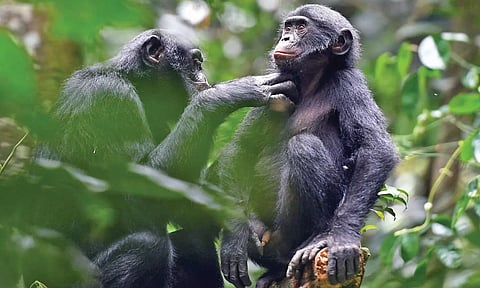

• CARL ZIMMER
If a troop of baboons encounters another troop on the savanna, they may keep a respectful distance or they may get into a fight. But human groups often do something else: They cooperate. Tribes of hunter-gatherers regularly come together for communal hunts or to form large-scale alliances. Villages and towns give rise to nations. Networks of trade span the planet. Human cooperation is so striking that anthropologists have long considered it a hallmark of our species. They have speculated that it emerged thanks to the evolution of our powerful brains, which enable us to use language, establish cultural traditions and perform other complex behaviors. But a new study, published in Science on Thursday, throws that uniqueness into doubt. It turns out that two groups of apes in Africa have regularly mingled and cooperated with each other for years.
“To have extended, friendly, cooperative relationships between members of other groups who have no kinship ties is really quite extraordinary,” said Joan Silk, a primatologist at Arizona State University who was not involved in the study. The new research comes from long-term observations of bonobos, an ape species that lives in the forests of the Democratic Republic of Congo. A century ago, primatologists thought bonobos were a slender subspecies of chimpanzee. But the two species are genetically distinct and behave in some remarkably different ways. Among chimpanzees, males hold a dominant place in society. They can be extremely violent, even killing babies. In bonobo groups, however, females dominate, and males have never been observed to commit infanticide. Bonobos often defuse conflict with sex, a strategy that primatologists have not observed among chimpanzees. Scientists made most of their early observations of bonobos in zoos. But in recent years they’ve conducted long-term studies of the apes in the wild.
Martin Surbeck, a behavioral ecologist at Harvard, in 2016 set up a new observational site in the Kokolopori Bonobo Reserve in the Democratic Republic of Congo. Working with the Mongandu people who live in neighboring villages, he set out on hikes through the forests in search of bonobos. On their first scouting trip, Dr. Surbeck was shocked to see what happened when the bonobo group they were following encountered another one. After some excited hooting, the apes settled down into a friendly gathering.
The encounter couldn’t have been more different than what happens between chimpanzee groups. Male chimpanzees typically patrol the boundaries of their ranges, ready to battle males from other groups. They will even climb hilltops to scan the horizon for other groups. “I just felt very privileged to witness this encounter,” Dr. Surbeck recalled.
Dr. Surbeck and his colleagues came to know the two groups of bonobos very well. They called one group, with 11 adults, Ekalakala. The other group, with 20 adults, came to be known as Kokoalongo. He and his colleagues observed 95 encounters between the two groups over the course of two years. Some lasted less than an hour, but others lasted days. Once, the Ekalakala and Kokoalongo groups lingered for two weeks before parting ways. During these mixers, the bonobos behaved much as they would in a single group. They groomed one another, shared food and cooperated to chase away snakes.